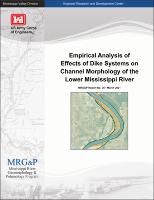Please use this identifier to cite or link to this item:
https://hdl.handle.net/11681/39799Full metadata record
| DC Field | Value | Language |
|---|---|---|
| dc.contributor.author | Mayne, Casey M. | - |
| dc.contributor.author | May, David P. | - |
| dc.contributor.author | Biedenharn, David S. | - |
| dc.date.accessioned | 2021-03-02T16:46:48Z | - |
| dc.date.available | 2021-03-02T16:46:48Z | - |
| dc.date.issued | 2021-03 | - |
| dc.identifier.govdoc | MRG&P Report No. 36 | - |
| dc.identifier.uri | https://hdl.handle.net/11681/39799 | - |
| dc.identifier.uri | http://dx.doi.org/10.21079/11681/39799 | - |
| dc.description | MRG&P Report | - |
| dc.description.abstract | A phased study of the dike fields within the Vicksburg and Memphis Districts of the US Army Corps of Engineers was conducted to document the channel morphology trends since dike construction on the Lower Mississippi River (LMR). This included the development of the hydrographic survey database and methodology utilized to identify changes in channel geometry in response to dike construction. A subsequent report will provide further refinements to the approach and results of the comprehensive assessment. Recent Mississippi River Geomorphology and Potamology program efforts have employed the database developed by Mr. Steve Cobb to assess the geomorphic changes in 21 dike systems along the LMR. Previous studies using this database have indicated that the dike fields have not caused a loss of channel capacity. Furthermore, these efforts suggested that the trends in the dike fields are closely related to the long-term geomorphic trends along the LMR. Previous efforts using the Cobb database provided considerable insight into the dike effects on the LMR, but they were limited spatially and temporally. In this study, a database and protocols were developed to allow for a more robust assessment of dike field impacts and to extend the spatial and temporal extents of the analysis. | en_US |
| dc.description.sponsorship | Mississippi River Geomorphology and Potamology Program (U.S.) | en_US |
| dc.description.tableofcontents | Abstract .......................................................................................................................................................... ii Contents ........................................................................................................................................................ iii Figures and Tables ........................................................................................................................................ iv Preface ............................................................................................................................................................. v 1 Introduction ............................................................................................................................................ 1 1.1 Background .................................................................................................................... 1 1.2 Objectives of study ........................................................................................................ 2 1.3 Approach ........................................................................................................................ 2 2 Methodology .......................................................................................................................................... 3 2.1 Hydrographic survey data ............................................................................................. 3 2.2 Channel delineation ...................................................................................................... 3 2.2.1 Advantages of the new approach. ................................................................................ 5 2.2.2 Limitations of the new approach................................................................................... 6 2.3 Time periods .................................................................................................................. 7 2.4 Cross-section data ......................................................................................................... 7 2.5 Volumetric data .............................................................................................................. 9 2.6 Dike data ........................................................................................................................ 9 2.7 Data analysis ............................................................................................................... 10 3 Analysis .................................................................................................................................................12 3.1 Cross-sectional analysis .............................................................................................. 12 3.2 Volumetric analysis ...................................................................................................... 18 3.3 Overall trends ............................................................................................................... 20 4 Summary and Conclusions ............................................................................................................... 23 5 Recommendations .............................................................................................................................. 26 References ................................................................................................................................................... 27 Unit Conversion Factors ............................................................................................................................ 28 Report Documentation Page | - |
| dc.format.extent | 36 pages / 1.68 MB | - |
| dc.format.medium | - | |
| dc.language.iso | en_US | en_US |
| dc.publisher | United States. Army. Corps of Engineers. Lower Mississippi Valley Division. | en_US |
| dc.publisher | United States. Mississippi River Commission. | - |
| dc.publisher | Coastal and Hydraulics Laboratory (U.S.) | - |
| dc.publisher | Engineer Research and Development Center (U.S.) | - |
| dc.relation.ispartofseries | MRG&P Report (Mississippi River Geomorphology and Potamology Program (U.S.));no. MRG&P Report No. 36 | - |
| dc.rights | Approved for Public Release; Distribution is Unlimited | - |
| dc.source | This Digital Resource was created in Microsoft Word and Adobe Acrobat | - |
| dc.subject | Channels (Hydraulic engineering) | en_US |
| dc.subject | Dikes (Engineering) | en_US |
| dc.subject | Geomorphology | en_US |
| dc.subject | Hydraulic structures | en_US |
| dc.subject | Mississippi River | en_US |
| dc.title | Empirical analysis of effects of dike systems on channel morphology of the Lower Mississippi River | en_US |
| dc.type | Report | en_US |
| Appears in Collections: | MRG&P Report | |
Files in This Item:
| File | Description | Size | Format | |
|---|---|---|---|---|
| MRG&P Report No 36.pdf | 1.68 MB | Adobe PDF |  View/Open |